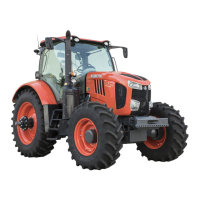What causes high battery voltage on Kubota M7-132 Tractor?
- JJonathan LopezAug 27, 2025
To resolve a battery voltage that is too high in your Kubota Tractor, check the battery specification and charging system.

What causes high battery voltage on Kubota M7-132 Tractor?
To resolve a battery voltage that is too high in your Kubota Tractor, check the battery specification and charging system.
How to set travelling speed to avoid invalid speed error on Kubota Tractor?
If you experience an invalid traveling speed error in your Kubota Tractor, set the traveling speed at 25 km/h (15 mph) or less.
Why Kubota M7-132 shows operational error due to invalid travelling speed?
To resolve an operational error due to invalid traveling speed on your Kubota Tractor, set the traveling speed from 0.5 km/h (0.3 mph) to 25 km/h (15 mph).
Why Kubota M7-132 Tractor shows operational error when handbrake is applied?
If the handbrake is applied, release it to resolve the operational error on your Kubota Tractor.
How to fix operational error related to engine rpm memory function on Kubota Tractor?
To address the operational error related to the engine rpm memory function in your Kubota Tractor, set the hand throttle to above idling.
How to record input of headland management system on Kubota M7-132?
When programming the headland management system on your Kubota Tractor, push the recording button again and operate the tractor.
What to do if headland management system operation is being stopped on Kubota Tractor?
To resolve the headland management system operation being stopped on your Kubota Tractor, replay the headland management system during driving.
Why headland management system operation is being stopped on Kubota Tractor?
To resolve the headland management system operation being stopped on your Kubota Tractor, check if the rear hitch is blocked. Replay the headland management system after releasing the hydraulic block.
How to solve operational error for PTO lever and PTO switch on Kubota M7-132?
To resolve an operational error for the PTO lever and PTO switch on your Kubota Tractor, ensure the PTO gear shift lever and PTO operating mode select lever position are not in neutral position when the PTO switch is on.
Why Kubota Tractor rear PTO stops with operational error?
To address an operational error related to rear PTO on your Kubota Tractor, note that the rear PTO operation is stopped due to engine rpm drop.
| Engine Power | 132 hp |
|---|---|
| Engine Type | 4-cylinder turbocharged diesel |
| Transmission | Power shift |
| Hydraulic System | Open center |
| Weight | 6, 800 kg |
| PTO Speed | 540/1000 RPM |
| Fuel Tank Capacity | 320 L |
Provides essential safety guidelines for tractor operation, including attention to safety labels and personal protective equipment.
Recommends CAB and ROPS use for safety, detailing precautions for their installation and maintenance.
Highlights the dangers of children near the tractor and prohibits their presence or operation.
Details critical safety procedures for operating the tractor on slopes to prevent tip-overs.
Provides safety instructions for road travel, including brake usage and speed management.
Provides an overview of the Intellipanel system's instrument panel, indicators, and displays.
Explains the LCD display functionality, including initial settings and information monitoring.
Guides on setting 3-point hitch functions, including lock, draft control, and lowering speed.
Details how to set and adjust remote control valves for hydraulic implements.
Describes how to set PTO operations, including automatic engagement and height settings.
Covers settings for automatic power shift transmission and engine parameters like rev-limit.
Details settings for CVT sensitivity, response, maximum speed, and engine rpm memory.
Explains how to record, save, load, delete, and modify headland management system programs.
Provides critical safety warnings and instructions for proper foot brake operation.
Details the operation and warning indicators related to the parking brake.
Details safety warnings and operational procedures for the shuttle lever.
Explains the selection and switching of 4WD and AUTO 4WD modes.
Details safety warnings and selection modes for the differential lock system.
Details how to preset and activate cruise control for maintaining a constant traveling speed.
Explains how to interpret Easy Checker™ indicators for troubleshooting tractor issues.
Details engine warning indicators related to control system errors and overheating.
Describes the engine oil pressure warning indicator and actions for low oil pressure.
Offers safety guidelines for road operation, including brake pedal locking and load balancing.
Provides critical safety advice for operating on slopes and uneven terrain to prevent accidents.
Covers rear PTO operation, including clutch control, RPM display, and external switches.
Details front PTO operation, including clutch control, RPM display, and shaft cover procedures.
Provides instructions for attaching implements, including lateral float and top link adjustments.
Details the operation of the front 3-point hitch, including lift control and remote hitch switches.
Explains the 3-point hitch controls, including lock, draft, position, and ride control settings.
Details the operation of remote hydraulic controls and valves for implements.
Explains airflow, air control vents, and operation modes for heating, cooling, and defrosting.
Provides a comprehensive chart of maintenance items and their corresponding service intervals.
Presents a chart detailing maintenance items based on hour meter readings and service intervals.
Lists recommended lubricants, fuels, and coolant types and capacities for the tractor.
Outlines regular maintenance tasks categorized by service intervals (hours/years).
Outlines essential daily inspection steps to ensure safe operation and machine longevity.
Specifies crucial initial servicing tasks required for a new tractor within the first 50 operating hours.
Details the servicing tasks to be performed after the first 50 operating hours on a new machine.
Lists maintenance tasks to be performed every 50 operating hours.
Specifies maintenance tasks to be performed every 100 operating hours.
Outlines maintenance tasks required every 200 operating hours.
Details maintenance tasks to be performed every 250 operating hours.
Lists maintenance tasks to be performed every 400 operating hours.
Specifies maintenance tasks to be performed every 500 operating hours.
Provides guidance on diagnosing and resolving issues with the electric control system.